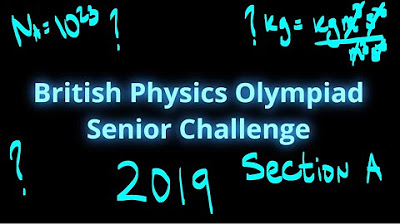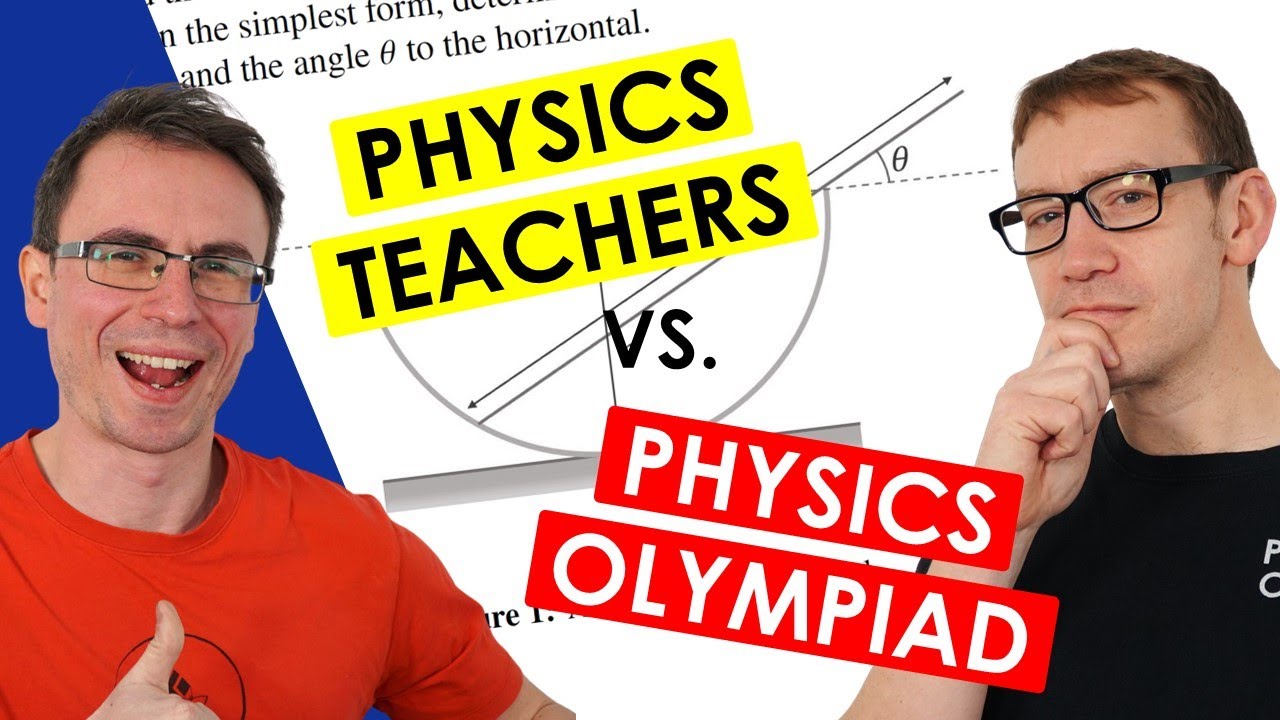Tips and overview of Round 1 of the British Physics Olympiad
TLDRIn this video, viewers are guided through tips for the upcoming British Physics Olympiad Round One. The host outlines the competition's format, including the division into two sections with varying problem lengths, and emphasizes the importance of attempting only the questions you feel confident about. Key strategies include practicing past papers, breaking down complex problems, and focusing on advanced techniques like dimensional analysis and calculus. The video also provides insights into how the competition is scored and encourages participants to enjoy the challenge of solving physics problems.
Takeaways
- 🎓 The video offers tips for the British Physics Olympiad Round 1, focusing on what to expect and how to prepare.
- 📅 The competition is split into two sections, each lasting about 1 hour and 20 minutes.
- 📜 Section 1 includes shorter problems, where students can attempt any part but are not expected to complete all.
- 📝 Section 2 involves longer problems, and students should use the five-minute reading time to choose two questions to focus on.
- 📐 It's crucial to show all working calculations, explanations, and diagrams to get full credit; creative solutions may earn additional points.
- 🔍 Past papers are available on the British Physics Olympiad website, and practicing these is highly recommended.
- 🏆 The top 50 students receive gold awards and an invitation to Round 2, while other top students receive various certificates.
- 💡 Key tips include breaking down complex problems into simpler parts, focusing on non-standard techniques like dimensional analysis, and using approximations effectively.
- 📊 Dimensional analysis and other advanced techniques not typically covered in A-levels can be very useful in the competition.
- 👍 Finally, it's important to enjoy the problems and the challenge that the competition provides.
Q & A
What is the main topic of the video?
-The main topic of the video is to provide tips and information about the upcoming round one of the British Physics Olympiad.
Who is the video primarily intended for?
-The video is primarily intended for students in year 12 and 13 who are sitting the British Physics Olympiad round one, not for those in the first year of A-level who will be taking the Physics Senior Challenge.
What is the format of the British Physics Olympiad round one?
-The British Physics Olympiad round one is split into two sections, each lasting one hour and 20 minutes. Section one contains short problems, and section two contains slightly longer problems.
What is the significance of the five-minute reading time before section two of the Olympiad?
-The five-minute reading time before section two allows students to read the questions without writing, and it is crucial for them to decide which two questions they will solve during the actual solving time.
What is the maximum mark a student can score for section one of the Olympiad?
-A student can score a maximum of 50 marks for section one of the Olympiad, even though the total marks available may vary from year to year.
What is allowed during the Olympiad exam?
-Students are allowed to use any standard exam boards data and formula sheet, and a calculator as long as it's not programmable or uses symbolic algebra.
What is the importance of showing working calculations, explanations, and diagrams in the Olympiad?
-Showing working calculations, explanations, and diagrams properly laid out is important for full credit, as creative solutions may also earn some points in physics Olympiads.
How are the awards allocated in the British Physics Olympiad?
-Awards are allocated based on the scores, with top 50 students receiving gold awards and invitations to round two, top 100 receiving gold certificates, top 200 silver certificates, and additional bronze categories for the next 300 students, with commendations for the top 1000.
What is the advice given for solving problems in the Olympiad?
-The advice given includes solving as many past papers as possible, breaking down complicated problems into simpler ones, focusing on non-standard techniques like dimensional analysis, calculus, and approximations.
Why is it recommended to focus on questions that seem easier or familiar during the Olympiad?
-Focusing on easier or familiar questions helps maximize the score, as students are not expected to complete all parts and should work on problems they are confident about.
What is the final tip given for students participating in the Olympiad?
-The final tip is to enjoy the problems, as the enjoyment of solving them is an important aspect of participating in physics competitions.
Outlines
😀 Overview of British Physics Olympiad Round One
This paragraph introduces the British Physics Olympiad round one, focusing on its structure and format. It distinguishes between section one and section two, detailing the time allocation, scoring, and permitted resources such as calculators and formula sheets. Emphasis is placed on showing workings for credit and leveraging creative solutions to maximize marks.
😀 Tips for Section One of British Physics Olympiad
Section one of the British Physics Olympiad round one is discussed here. It covers the time limit, scoring details, and the importance of selective problem solving. Advice includes using provided constants and expansions effectively, and focusing on easier marks first while ensuring comprehensive working out is shown.
😀 Strategies for Section Two of British Physics Olympiad
This paragraph outlines section two of the British Physics Olympiad round one. It explains the five-minute reading period before solving, where candidates must choose two questions out of five. Tips are given on selecting questions based on familiarity and confidence in topics like quantum mechanics, dynamics, and circular motion.
😀 Awards and Recognition at British Physics Olympiad
Here, the official recognition and awards system of the British Physics Olympiad are detailed. It lists the different categories of certificates awarded based on performance levels, from gold awards for top performers to commendations for broader achievers. The paragraph also mentions the availability of past papers and mark schemes for preparation.
😀 Advanced Techniques for British Physics Olympiad Success
This paragraph offers advanced tips for excelling in the British Physics Olympiad. It suggests techniques like breaking down complex problems into simpler components, employing dimensional analysis and calculus, and using approximations effectively. The importance of enjoying the problem-solving process is emphasized as integral to success in physics competitions.
Mindmap
Keywords
💡British Physics Olympiad
💡Round One
💡Section One
💡Section Two
💡Past Papers
💡Mark Scheme
💡Dimensional Analysis
💡Approximations
💡Certificates
💡Newton's Second Law
Highlights
Introduction to tips for the upcoming British Physics Olympiad round one.
Format of the competition: two sections, each lasting about one hour and 20 minutes.
Advice for first-year A-level students: focus on the Physics Senior Challenge.
Section one contains shorter problems; students are not expected to complete all parts.
Emphasis on showing all work, including calculations, explanations, and diagrams.
Creative solutions can earn points; maximum score for section one is 50 marks.
Students may use standard data and formula sheets, and non-programmable calculators.
Importance of writing name and school on each answer sheet.
Section two involves choosing two questions from five during a five-minute reading time.
Focus on familiar topics and pick questions similar to ones seen before.
Awards allocation: top 50 students receive gold and invitation to round two.
Tips for success: solve as many past papers as possible.
Break down complicated problems into simpler parts using Newton's second law.
Focus on non-standard techniques like dimensional analysis and calculus.
Enjoy solving problems, as this is the core reason for participating in physics competitions.
Transcripts
Browse More Related Video

My Solutions: British Physics Olympiad Round 1 2020 - Section 1 a to c

My Solutions to the British Physics Olympiad, BPhO Senior Challenge 2019 Multiple Choice

Unofficial Physics Olympiad Answers - 2023 BPhO Senior Physics Challenge

A Level Physics Teachers Take On Olympiad Questions

HOW is the speed ZERO when rolling? Bulgarian Physics Olympiad

Equations of Motion Sums
5.0 / 5 (0 votes)
Thanks for rating: